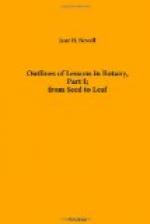The series of Corn seedlings, at least, should be drawn as before and the parts marked, this time with their technical terms. The following questions should then be prepared.
CORN.
What are the parts of the seed?
Compare these parts with the Morning-Glory, Sunflower, Bean, and Pea.
Where is the food stored?
How many cotyledons have Corn, Wheat, and Oats?
How many have Bean, Pea, Morning-Glory, and Sunflower?
Compare the veins of the leaves of each class and see what difference you can find.
This will bring up the terms dicotyledon and monocotyledon. Di means two, mono means one. This difference in the veins, netted in the first class, parallel in the second, is characteristic of the classes. Pupils should have specimens of leaves to classify under these two heads. Flowering plants are divided first into these two classes, the Dicotyledons and the Monocotyledons.
If Pine-seeds can be planted, the polycotyledonous embryo can also be studied.
7. Food of seedlings.—The food of the Wheat seedling may be shown in fine flour. [1]"The flour is to be moistened in the hand and kneaded until it becomes a homogeneous mass. Upon this mass pour some pure water and wash out all the white powder until nothing is left except a viscid lump of gluten. This is the part of the crushed wheat-grains which very closely resembles in its composition the flesh of animals. The white powder washed away is nearly pure wheat-starch. Of course the other ingredients, such as the mineral matter and the like, might be referred to, but the starch at least should be shown. When the seed is placed in proper soil, or upon a support where it can receive moisture, and can get at the air and still be warm enough, a part of the starch changes into a sort of gum, like that on postage stamps, and finally becomes a kind of sugar. Upon this sirup the young seedling feeds until it has some good green leaves for work, and as we have seen in the case of some plants it has these very early.”
[Footnote 1: Concerning a Few Common Plants, page 18.]
The presence of starch can be shown by testing with a solution of iodine. Starch is turned blue by iodine and may thus be detected in flour, in seeds, in potatoes, etc.
After all this careful experimental work the subject may be studied in the text-book and recited, the recitation constituting a thorough review of the whole.
A charming description of the germination of a seed will be found in the Reader. V. The Birth of Picciola.
Gray’s Lessons. Sect. II, 8-14. III. How Plants Grow. Sect. I, 22, 23. II.
III
ROOTS.
This subject can be treated more conveniently while the young seedlings are still growing, because their roots are very suitable for study. It seems best, therefore, to take it up before examining the buds.




